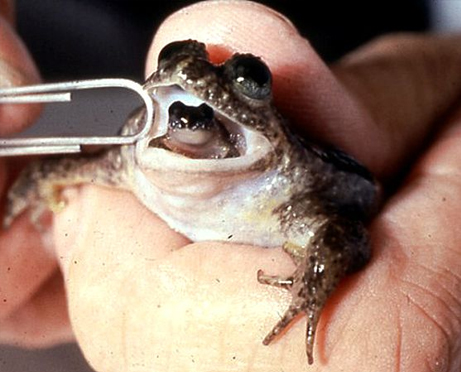Lazarus Project scientists create an embryo from extinct frog DNA

Mike Archer at the University of New South Wales has been working on what is referred to as the "Lazarus Project." His goal: To resurrect the southern gastric brooding frog. He and his team have a good start on it.
The southern gastric brooding frog, Rheobatrachus silus, was first discovered in Queensland, Australia in 1972. No one had much interest in the frog, however, until its reproductive methods were discovered in 1974 by Mike Tyler. The last time one of these frogs was seen in the wild was in 1979 or 1981. The last one in captivity died in 1983.
According to National Geographic, the female gastric brooding frog turns her stomach into a womb. First, she swallows her eggs. She doesn't digest them because she stops making hydrochloric acid. In time, 20-25 tadpoles hatch inside her stomach. For six weeks, they grow while the mother becomes so bloated that her lungs collapse; she then has to breathe through her skin. Once they're ready, mom gives birth to fully-formed froglets through "propulsive vomiting." (And we think it's tough for us to give birth!)
Luckily, Mike Tyler (the person who first discovered the frog's reproductive methods) kept tissue samples from gastric brooding frogs in his freezers. These were just regular deep freezers, folks. Mike Archer and his team of scientists were able to extract DNA from these tissue samples and insert it into eggs from the barred frog, a close relative of the gastric brooding frog. They did this by destroying the nucleus of the barred frog egg and inserting it, instead, with the nucleus of a cell from the gastric brooding frog. This was done to hundreds of eggs until one finally divided into an embryo with hundreds of cells.
Unfortunately, the story doesn't go much further. Each time they've gotten to the embryo stage, the ball of cells collapses on itself, a process known as gastrulation, and stops growing.
While they've not even reached the tadpole stage, Archer is confident that it will happen in time. He believes that we have a moral responsibility to bring back animals from extinction, if we can, if we somehow contributed to their demise. Critics of his research believe that it's a bit of a waste to put so much money into bringing back an animal from extinction when we have so many right on the verge of dying out.
Do you think we should try to resurrect extinct species? Why or why not?
Photo copyright of Mike Tyler.
0 comments